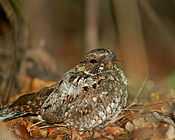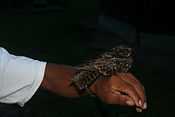List of Caprimulgiformes by population
This is a list of Caprimulgiformes species by global population. While numbers are estimates, they have been made by the experts in their fields. For more information on how these estimates were ascertained, see Wikipedia's articles on population biology and population ecology.
This list is not comprehensive, as not all Caprimulgiformes have had their numbers quantified.
Species by global population
| Common name | Binomial name | Population | Status | Trend | Notes | Image |
|---|---|---|---|---|---|---|
| New Caledonian owlet-nightjar | Aegotheles savesi | 50[1] | CR[1] | Maximum estimate.[1] | ||
| White-winged nightjar | Eleothreptus candicans | 1000 – 2499[2] | EN[2] | |||
| Puerto Rican nightjar | Caprimulgus noctitherus | 1400 – 2000[3] | EN[3] |  | ||
| Solomons frogmouth | Rigidipenna inexpectata | 2500 – 9999[4] | NT[4] | Preliminary estimate.[4] | ||
| Prigogine's nightjar | Caprimulgus prigoginei | 3500 – 15 000[5] | EN[5] | |||
| Satanic nightjar | Eurostopodus diabolicus | 3500 – 15 000[6] | VU[6] | |||
| Salvadori's nightjar | Caprimulgus pulchellus | 6000 – 15 000[7] | NT[7] | |||
| Sickle-winged nightjar | Eleothreptus anomalus | 10 000[8] | NT[8] | Minimum estimate.[8] | ||
| Least poorwill | Siphonorhis brewsteri | 10 000 – 19 999[9] | NT[9] | |||
| Bonaparte's nightjar | Caprimulgus concretus | 15 000 – 30 000[10] | VU[10] | |||
| Eared poorwill | Nyctiphrynus mcleodii | 20 000 – 49 999[11] | LC[11] | |||
| Yucatan poorwill | Nyctiphrynus yucatanicus | 20 000 – 49 999[12] | LC[12] |  | ||
| Northern potoo | Nyctibius jamaicensis | 50 000 – 499 999[13] | LC[13] | .jpg) | ||
| Short-tailed nighthawk | Lurocalis semitorquatus | 50 000 – 499 999[14] | LC[14] | |||
| Spot-tailed nightjar | Caprimulgus maculicaudus | 50 000 – 499 999[15] | LC[15] |  | ||
| Yucatan nightjar | Caprimulgus badius | 50 000 – 499 999[16] | LC[16] | |||
| Red-necked nightjar | Caprimulgus ruficollis | 130 000 – 1 500 000[17] | LC[17] | Very preliminary estimate.[17] |  | |
| Great potoo | Nyctibius grandis | 500 000 – 4 999 999[18] | LC[18] |  | ||
| European nightjar | Caprimulgus europaeus | 2 000 000 – 6 000 000[19] | LC[19] |  | ||
See also
- Lists of birds by population
- Lists of organisms by population
References
- ↑ 1.0 1.1 1.2 1.3 BirdLife International (2012). "Aegotheles savesi". IUCN Red List of Threatened Species. Version 2012.2. IUCN. Retrieved 2012-12-05.
- ↑ 2.0 2.1 2.2 BirdLife International (2012). "Eleothreptus candicans". IUCN Red List of Threatened Species. Version 2012.2. IUCN. Retrieved 2012-12-05.
- ↑ 3.0 3.1 3.2 BirdLife International (2012). "Caprimulgus noctitherus". IUCN Red List of Threatened Species. Version 2012.2. IUCN. Retrieved 2012-12-05.
- ↑ 4.0 4.1 4.2 4.3 BirdLife International (2012). "Rigidipenna inexpectata". IUCN Red List of Threatened Species. Version 2012.2. IUCN. Retrieved 2012-12-05.
- ↑ 5.0 5.1 5.2 BirdLife International (2012). "Caprimulgus prigoginei". IUCN Red List of Threatened Species. Version 2012.2. IUCN. Retrieved 2012-12-05.
- ↑ 6.0 6.1 6.2 BirdLife International (2012). "Eurostopodus diabolicus". IUCN Red List of Threatened Species. Version 2012.2. IUCN. Retrieved 2012-12-05.
- ↑ 7.0 7.1 7.2 BirdLife International (2012). "Caprimulgus pulchellus". IUCN Red List of Threatened Species. Version 2012.2. IUCN. Retrieved 2012-12-05.
- ↑ 8.0 8.1 8.2 8.3 BirdLife International (2012). "Eleothreptus anomalus". IUCN Red List of Threatened Species. Version 2012.2. IUCN. Retrieved 2012-12-05.
- ↑ 9.0 9.1 9.2 BirdLife International (2012). "Siphonorhis brewsteri". IUCN Red List of Threatened Species. Version 2012.2. IUCN. Retrieved 2012-12-05.
- ↑ 10.0 10.1 10.2 BirdLife International (2012). "Caprimulgus concretus". IUCN Red List of Threatened Species. Version 2012.2. IUCN. Retrieved 2012-12-05.
- ↑ 11.0 11.1 11.2 BirdLife International (2012). "Nyctiphrynus mcleodii". IUCN Red List of Threatened Species. Version 2012.2. IUCN. Retrieved 2012-12-05.
- ↑ 12.0 12.1 12.2 BirdLife International (2012). "Nyctiphrynus yucatanicus". IUCN Red List of Threatened Species. Version 2012.2. IUCN. Retrieved 2012-12-05.
- ↑ 13.0 13.1 13.2 BirdLife International (2012). "Nyctibius jamaicensis". IUCN Red List of Threatened Species. Version 2012.2. IUCN. Retrieved 2012-12-05.
- ↑ 14.0 14.1 14.2 BirdLife International (2012). "Lurocalis semitorquatus". IUCN Red List of Threatened Species. Version 2012.2. IUCN. Retrieved 2012-12-05.
- ↑ 15.0 15.1 15.2 BirdLife International (2012). "Caprimulgus maculicaudus". IUCN Red List of Threatened Species. Version 2012.2. IUCN. Retrieved 2012-12-05.
- ↑ 16.0 16.1 16.2 BirdLife International (2012). "Caprimulgus badius". IUCN Red List of Threatened Species. Version 2012.2. IUCN. Retrieved 2012-12-05.
- ↑ 17.0 17.1 17.2 17.3 BirdLife International (2012). "Caprimulgus ruficollis". IUCN Red List of Threatened Species. Version 2012.2. IUCN. Retrieved 2012-12-05.
- ↑ 18.0 18.1 18.2 BirdLife International (2012). "Nyctibius grandis". IUCN Red List of Threatened Species. Version 2012.2. IUCN. Retrieved 2012-12-05.
- ↑ 19.0 19.1 19.2 BirdLife International (2012). "Caprimulgus europaeus". IUCN Red List of Threatened Species. Version 2012.2. IUCN. Retrieved 2012-12-05.

